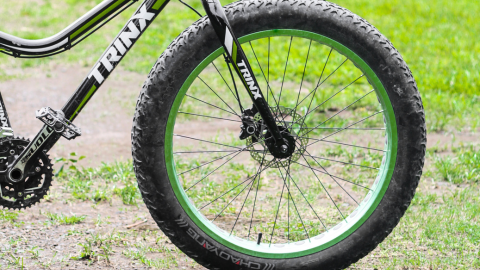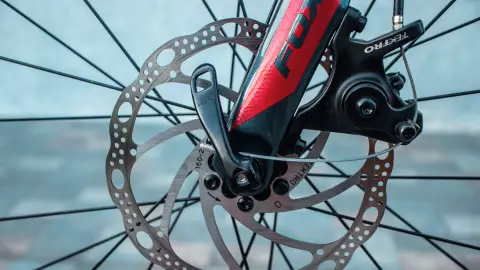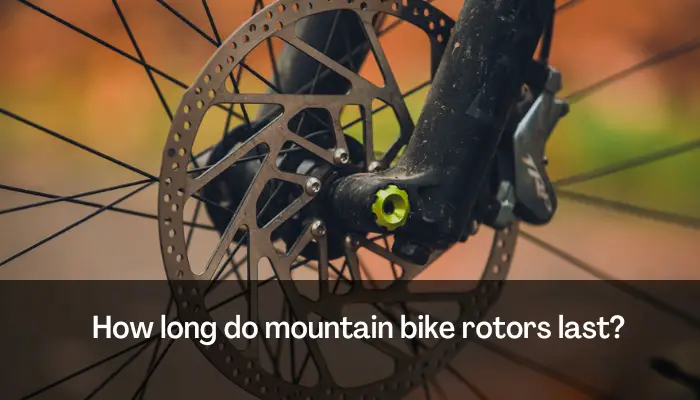Mountain bikes are not cheap. So, when they break, you don’t just throw them away. Instead, you take them apart and try to fix them yourself. There are parts available online that allow you to rebuild a mountain bike frame.
Mountain biking is a great sport. For mountain bikers, disc brakes are a total game-changer. They stop you quickly and reliably on different surfaces and respond quickly.
Disc brakes offer improved safety, but they need more regular maintenance. The friction pads used in mountain bike disc brakes wear out far faster than the stainless steel brake pads used in road bikes.
In this article, You’ll get to know about the long-lasting capacity of an MTB’s rotor and how to prolong its life. So, Stay with us.
What is the average life expectancy of rotors?

The average lifespan of a rotor is between 10 and 12 years, depending on how much maintenance they receive after purchase. If a rotor has been well maintained, it should last longer. Rotor blades should be inspected once per year for cracks or other damage.
To the tune of 700 kilometers, assuming your bike is equipped with resin disc brakes. Sintered metal disc brakes, however, have a maximum lifespan of 1,250 miles. This means that if you bought one new rotor at $100 each and another new rotor at $150 each, then after two years, you would have spent $250 for two rotors instead of $400.
It still boils down to factors like the weather, your braking techniques, and the road surface. Therefore, the disc pads need to be checked and replaced on a regular basis if you want them to survive as long as possible.
How do I know if my Mountain Bike Rotors are Worn?
If you notice any unusual noises from your bicycle when riding, then it could be due to worn-out rotors.
The noise is caused by the friction between the tire treads and the brake pads. When the brakes are applied, the rotor spins against the pad. This causes heat buildup, which eventually wears down the braking surface.
Rotor wear happens when the brake pads rub against the rotor, causing them to become worn out. This usually occurs after about 500 miles of riding. If you notice any unusual sounds coming from your brakes, stop immediately and call for service.
How often to replace mountain bike rotors?
In most cases, a brake rotor only needs to be replaced after ten years.
Many people just install disc brake rotors and forget about them because they last so long. Rotor manufacturers, however, typically list the absolute bare minimum thickness for their products.
The brake fluid is leaking because the rubber seals have worn down with age. New ones are preferable to rebuilding. However, rebuilding is possible. The slides, bushings, and pins should all be inspected. Look for signs of rust, cracks, or other deterioration. Replace worn bushings, slides, and mounting hardware, and apply enough grease before installing the new part.
When to replace mountain bike rotors?
Mountain bikes need new brake pads after approximately 4,000 miles, and then they should be replaced again at about 10,000 miles.
If you want to prevent this, you should change them once a year. The best method to do this is to use a tool called a rotor gauge, which allows you to check the thickness of each pad. This will help you determine whether or not you need to replace them.
The required thickness of a rotor is usually stamped somewhere on its outer surface. The range of possible sizes is from 1.7mm to 1.5mm.
Although you may have heard otherwise from your fellow cyclists, contaminated rotors rarely necessitate replacement. In light of the fact that high-end rotors typically cost more than $100 for a pair, this is encouraging news. According to some experts, all that’s needed to clean them is a lot of rubbing alcohol and some fresh paper towels.
The easiest solution for a glazed rotor is to replace it. However, it is feasible to wear through the glaze and restore performance with enough time and effort. The glazing can be rapidly removed by soaking the brakes in extremely clean water and repeating the break-in operation. As a result, the pad material dust can be used as a polishing compound, and the process appears to be successful.
Disc rotor minimum thickness

The Disc Rotor must be at least 5 mm thick.
The thickness of the brake pads needs to be measured. Continuously, such as throughout the process of inflating tires. Verify the pressure. The minimum period is three months.
Shimano suggests replacing its rotors, which have a starting thickness of 1.8mm but wear down to 1.5mm after repeated stops. The rotor displays this data, “Min.TH=1.5.”
SRAM rotors have an initial thickness of 1.85 mm, while some of its 140 mm rotors are 1.9 mm, and should be removed once they reach 1.55 mm.
Inquire about the specifics of the rotors you plan to utilize, as different manufacturers have varied minimum thickness requirements. You’ve waited too long if you can cut through a ham with it.
Conclusion
In conclusion, mountain biking is a sport that involves riding over rough terrain through a variety of environments. This means that your equipment is going to take a beating. However, unlike traditional bikes, mountain bikes typically use wider tires than their road counterparts. These larger wheels provide greater traction and stability, which helps reduce the chance of falling off and ensures that your ride lasts longer.
To help keep your bike from wearing out too quickly, make sure to regularly check its condition. A quick visual inspection is usually sufficient, but if you notice anything suspicious, such as damaged spokes or bent rims, you should bring it straight to the shop. Even though your bike might look fine right now, it’s never a bad idea to take a look inside to make sure that nothing has gone wrong.
As far as maintenance goes, it’s best to avoid using harsh chemicals like brake cleaner or motor oil on your bike. Instead, opt for products made specifically for cleaning your components. This will ensure that they stay clean and protected throughout your entire ride.

I am Ryan Ford, a mountain biking enthusiast who loves to explore the outdoors. I also like to go on adventures with friends and anything else that involves being outside. I love my bike because it gets me out of the house and gives me an opportunity to enjoy nature.

